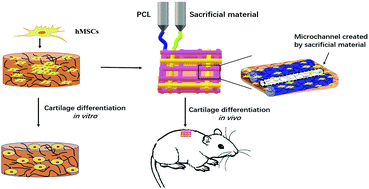HBC-nanofiber hydrogel scaffolds with 3D printed internal microchannels for enhanced cartilage differentiation†
Abstract
Articular cartilage injuries are a major orthopedic problem. Cartilage repair is a long-standing challenge due to the limited self-regenerative capability of cartilage. Tissue engineering offers a new and effective approach to cartilage repair. We report herein the fabrication of 3D scaffolds that mimic the native structure of cartilage, by first preparing poly(lactic-co-glycolic acid) (PLGA) electrospun nanofiber incorporated hydroxybutyl chitosan (HBC) hydrogels (HBC-NF hydrogels) and then injecting the hydrogels into a 3D printed poly(ε-caprolactone) (PCL) framework with internal microchannels for improved mechanical support and substance exchange. The thus-obtained HBC-NF hydrogels exhibited outstanding gelation properties with a gelling time of no more than 15 s at 37 °C. With the incorporation of the nanofibers, human mesenchymal stem cells (hMSCs) showed good proliferation in the HBC-NF hydrogels. The relative gene expression levels for mesenchymal condensation and matrix deposition significantly increased in the HBC-NF hydrogels due to the addition of the nanofibers, suggesting substantially enhanced cartilage differentiation. Furthermore, the injection of the HBC-NF hydrogels into the 3D printing PCL framework led to the formation of 3D scaffolds with significantly improved mechanical performance. More importantly, the construction of regulable internal microchannels for cell growth and the exchange of nutrients and waste products were achieved via co-printing of PCL and a sacrificial material, Pluronic F-127. The PCL reinforced HBC-NF hydrogel scaffolds with internal microchannels showed enhanced chondrogenesis and mechanical properties in vivo. In summary, the current work has demonstrated that PCL framework reinforced HBC-NF hydrogels with tunable internal microchannels provide an ideal biomimetic microenvironment for the growth and cartilage differentiation of hMSCs, therefore holding promise for potential applications in cartilage tissue engineering.

- This article is part of the themed collection: Editor’s Choice: Tissue Engineering


 Please wait while we load your content...
Please wait while we load your content...